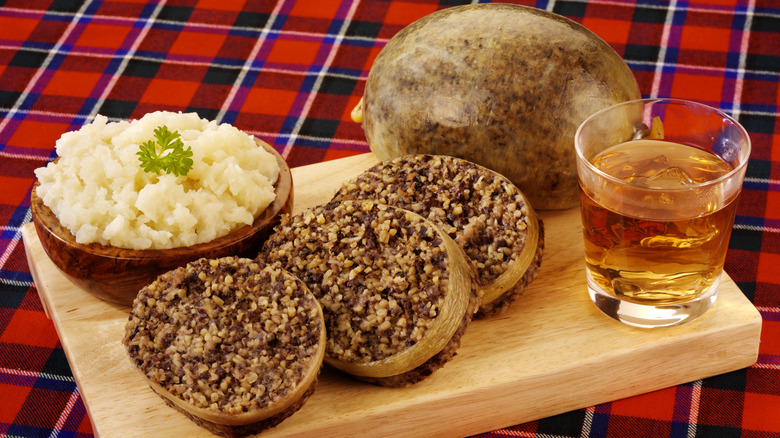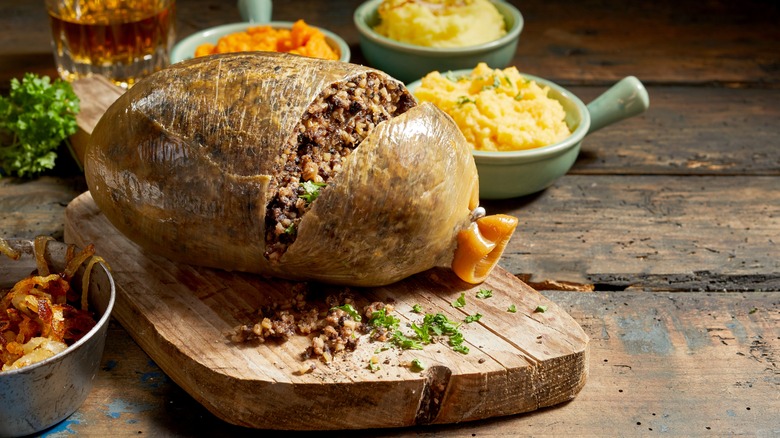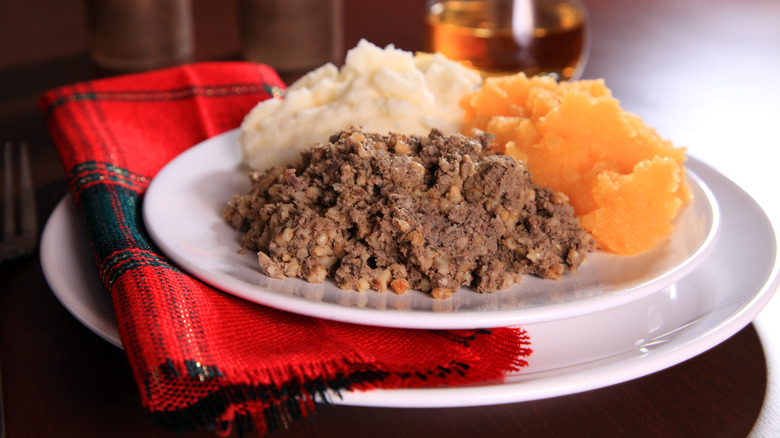What Is Haggis Made Of — And Why Is It Banned In The US?
Haggis is the national dish of Scotland, and you'd be hard-pressed to find a deeper connection between a people and their food. Listen to a Scotsman describe haggis, and you'd think he was speaking about his soulmate. The 18th-century poet Robert Burns once wrote an ode to the stuff — now recited every year on Burns Night — which praises the life-giving nature of a hearty haggis, even to the point of diminishing the cuisines of other European nations. "But mark the Rustic, haggis-fed, The trembling earth resounds his tread," proudly waxed Burns (via Scottish Poetry Library).
Granted the person even knows what haggis is, outside of Scotland, the dish is met with some blend of curiosity and revulsion, particularly in the U.S., where offal has never been widely consumed. Haggis consists of the lungs, liver, and heart of a sheep, all ground up and mixed with oats, onion, beef suet, and spices. Traditionally, the mixture is stuffed into a sheep's stomach and boiled, but today, synthetic casings are often used instead. It is traditionally eaten alongside mashed potatoes and turnips, known to Scots as "neeps and tatties".
American popular culture has often made haggis the subject of mockery — but this may be a case of rejecting what you don't understand because haggis has been illegal in the U.S. for some time. And while visually the bulbous sausage is not the most attractive of foods, its rich peppery kick and hearty moist blend of savory flavors is hard to resist once tried.
Haggis is banned in the U.S. because of one ingredient
Americans cannot import haggis from Scotland, nor can they make it at home, at least, not a truly authentic version. That's because haggis contains sheep lungs, which are illegal to eat in the U.S. According to the Federal Code of Regulations, "Livestock lungs shall not be saved for use in human food," and this rule has effectively made Scotland's national dish inaccessible to most Americans.
The American ban on lung meat dates back to 1971 when a team of USDA scientists dissected hundreds of cow lungs to assess their health and safety. They found pollen and fungal spores deep in the porous lung tissue and decided that this made lungs unfit for human consumption. Critics of the ban have countered by pointing out that human lungs contain the same contaminants, and we are constantly swallowing the contents of our own lungs every day without consequence. Furthermore, livestock lungs are eaten in many other parts of the world, and they have not caused any significant health concerns.
Typically, high temperatures would be considered sufficient to eliminate any risk, but lung meat tends to get tough, so people often undercook it. This was a factor in the USDA's initial concern. However, the lung meat used in haggis is finely ground and mixed with oats, spices, and other cuts so that it may be fully cooked without turning too dry. Petitions have called for the USDA to reverse its ban, but as of now, the rule stands.
Haggis as a cultural symbol
The United States' ban on haggis has been the ire of Scots residing here. Scottish actor Sam Heughan, star of the TV series "Outlander" had to smuggle a haggis past airport security just so he and his co-stars could enjoy a proper Burns Night in Los Angeles. To understand why anyone would go through such trouble, you need to recognize that haggis is more than food; it's a symbol of Scottish culture, in particular the nation's fraught relationship with England.
Nobody knows exactly where, when, or by whom haggis was invented, but we do know that it didn't originate in Scotland. Similar dishes existed in Ancient Rome, Viking-era Scandinavia, and elsewhere, and it probably originated out of practicality. Offal spoils rapidly, so stuffing it into an empty stomach for cooking and transport was likely part of ancient hunting practices. The first written references to haggis emerged in England around the 1400s.
Haggis became a Scottish staple in the 17th century, largely for political reasons. The Agricultural Revolution made more varieties of food accessible in England, reducing demand for offal, but in Scotland, there was economic hardship, and using every part of the animal remained essential for getting by. Wealthy Englishmen began to use haggis as a means of mocking the Scots for their lower economic class, a stereotype Robert Burns sought to counter in his ode. Centuries later, haggis still endures as a symbol of Scottish strength and resilience.


